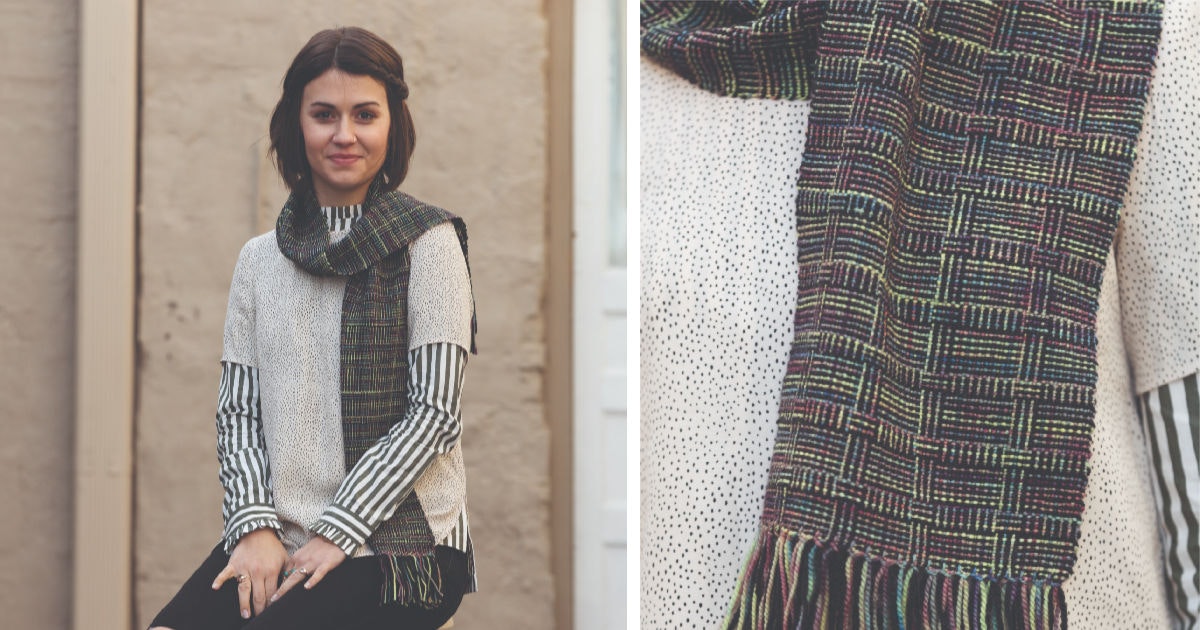Plain weave is not only the simplest of weave structures, it’s also the most versatile, especially when you start playing with color. "Color-and-weave" refers to the different ways you can combine colors in the warp and weft to create patterns that look anything but plain. The possibilities of color-and-weave are only limited by your imagination! For more ideas on color-and-weave, as well as tips and tricks for weaving it well, check out Sara Bixler's new video course Color-and-Weave on the Rigid-Heddle Loom.
1. Small Squares
This color-and-weave technique creates a pattern of small squares perfect for playing with contrasting yarns. To create the gridded pattern, warp the loom with one color and then weave with two colors in the weft: the same color as the warp and a second contrasting color. You can take this pattern further by using different sizes of yarns in the weft or adding a third (or even fourth!) color to the weft. Just make sure every other pick matches your warp color.
2. Checked Pattern
To create this checked pattern, warp the loom with four ends of coral followed by four ends of a darker variegated yarn, repeating across the warp. Then weave so the weft follows the same color order as the warp, creating squares on the cloth. The variegated yarn gives the checks an almost ombré effect, but you can use a solid yarn to get a more traditional checked pattern.
3. Log Cabin
Log cabin alternates two contrasting colors in the warp and weft to create a pattern that tricks the viewer’s eye. It looks complicated, but it’s still plain weave. In this sample, the pattern (six ends of aqua alternating with six ends of cherry, followed by three ends of cherry alternating with three ends of aqua) is repeated across the warp and mirrored in the weft. The blocks of pattern are created when two ends or picks of the same color are used side by side. To take log cabin to the next level, try pairing a variegated yarn with a contrasting solid, as in Whitney Dorband’s Stormy Seas Scarf on page 24 of Easy Weaving With Little Looms 2017.

Whitney Dorband's Stormy Seas Scarf from Easy Weaving with Little Looms 2017 Photo by George Boe
4. Low-Contrast Log Cabin
Log cabin tends to work best when yarns with high contrast are used together, but low-contrast yarns can also be used for different effects. In sample 4A, aqua paired with lime creates a more delicate log cabin pattern. While the pattern is still log cabin, the pattern doesn’t “pop” as much, and it creates a variegated effect with two solid-colored yarns. When using low-contrast variegated yarns, though, be careful. In sample 4B, two low-contrast variegated yarns are used in warp and weft. While the overall effect is still lovely, the log cabin is completely obscured.
5. More Color-and-Weave
In this last sample, the pattern repeats three ends of each color in the warp and alternates between picks of each color in the weft. The result is a fun, reversible pattern that looks a bit like a beanstalk. To “turn” the pattern so the lines are horizontal, simply switch the warp-color and weft-color orders.
Yarns shown above: Small Squares, Checked Pattern: Universal Yarn Uptown and Universal Yarn Classic Shades. Log Cabin, Low-Contrast Log Cabin Sample 4A, and More Color-and-Weave: Universal Yarn Uptown. Low-Contrast Log Cabin Sample 4B: Ancient Arts Fibre Craft Sport Weight 100% Merino.
Originally published 6/30/2022; updated 10/22/2024

